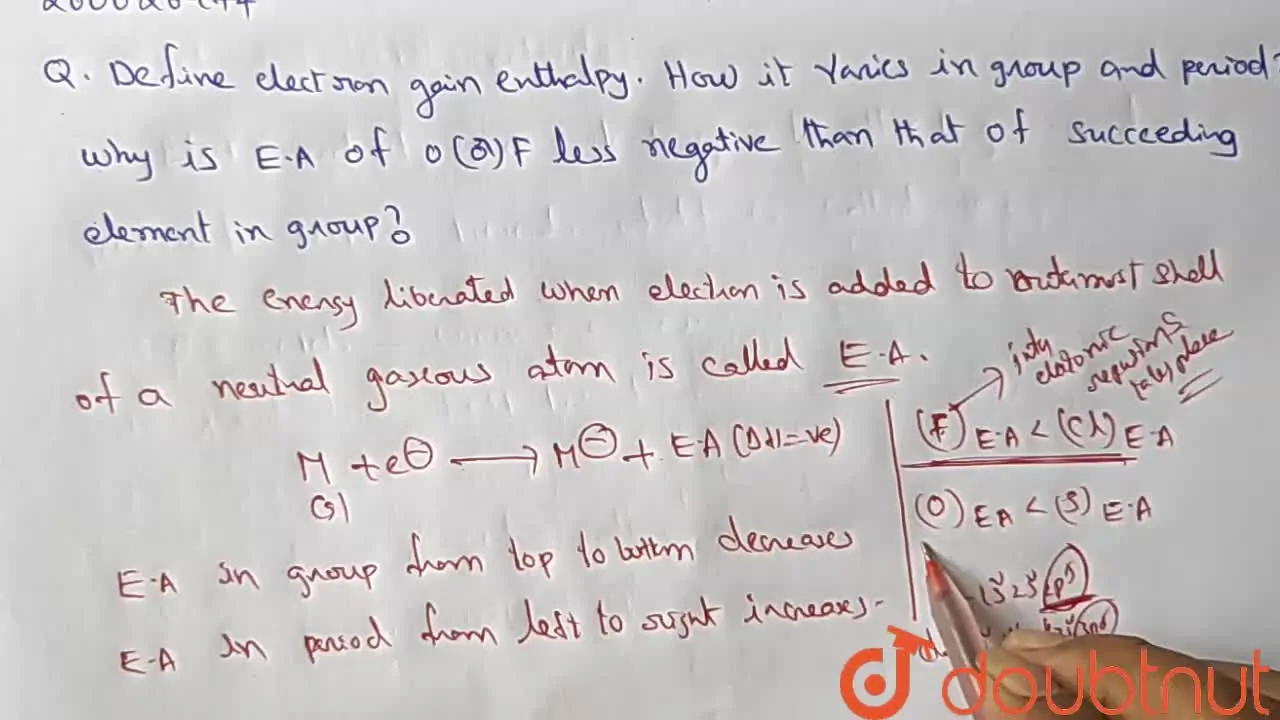Define electron gain enthalpy. How it varies in a group and in a period ? Why is the electron gain enthalpy of O or F is less negative than that of succeeding element in the group ? Solution in Telugu
(1) Electron affinity is the amount of energy released when an electron is added to a neutral gaseous atom in its ground state. It is known as first Electron affinity . It has -ve value.
(2) Energy can be absorbed when an other electron is added to uninegative ion. It is because to overcome the repulsion between negative ion and electron. Hence second electron affinity, has +ve value,
(3) It can be indirectly determined from Born- Haber cycle. Its units are kJ/mole
4. Trend in a group: Generally EA decreases down the group. In a group the second element has higher EA value than the first member. e.g: EA of Cl is more than that of F
Fluorine possess lower EA value than chlorine. It is due to inner electron repulsions in Fluorine.
5. Trend in a period: Generally EA value increases across a period, but some irregularities can be observed.
(a) IA group elements possess low EA values than the corresponding IIIA elements. e.g: Be has EA value zero, it is due to completely filled orbital.
(b) VA elements have low EA values than that of VI A elements. e.g: Due to presence of half filled p-orbitals , nitrogen has lower EA value than that of oxygen.
(c ) For inert gases EA value is zero.
(d) The element with the highest EA value is chlorine.
The electron gain enthalpy of O and F is less negative than the succeeding element in the group because. These have small size and inter electronic repulsions are high in these elements
KJ/mole and kJ/mole
KJ/mole and kJ/mole
Related Playlists
- BOOK - VIKRAM PUBLICATION ( ANDHRA PUBLICATION)CHAPTER - CLASSIFICATION OF ELEMENTS AND PERIODICITY IN PROPERTIESEXERCISE - Short Answer Questions38videos
CLASSIFICATION OF ELEMENTS AND PERIODICITY IN PROPERTIES
- BOOK - VIKRAM PUBLICATION ( ANDHRA PUBLICATION)CHAPTER - CHEMICAL EQUILIBRIUM AND ACIDS BASES EXERCISE - LONG ANSWER QUESTIONS31videos
CHEMICAL EQUILIBRIUM AND ACIDS BASES
- BOOK - VIKRAM PUBLICATION ( ANDHRA PUBLICATION)CHAPTER - ENVIRONMENTAL CHEMISTRYEXERCISE - LONG ANSWER QUESTIONS6videos
ENVIRONMENTAL CHEMISTRY
Similar Questions
On the basis of quantum numbers, justify that the 6th period of the periodic table should have 32 elements.
07:14View SolutionWhat are equilibrium processes? Explain equilibrium in Physical and Chemical processes with examples.
04:16View SolutionWhat is environmental pollution? How many types of pollution are encountered?
03:55View Solutionइलेक्ट्रान लब्धि एन्थेलपी को परिभाषित कीजिए । कुछ तत्वों की इलेक्ट्रान लब्धि एन्थेलपी धनात्मक क्यों होती है ? इलेक्ट्रान लब्धि एन्थेलपी किसी समूह तथा आवर्त में किस प्रकार परिवर्तित होती है ?
03:48View SolutionWhy is the electron gain enthalpy of O or F less than that of S or Cl?
01:43View SolutionAssertion:For the elements O or F,the electron gain enthalpy is less negative than that of the succeeding element. Reason:Electron gain enthalpy becomes less negative as we go down a group.
01:19View SolutionExplain why the electron gain enthalpy of the fluorine is less negative than that of chlorine
03:21View SolutionHow does the electron gain enthalpies vary across a period and down a group ?
05:50View SolutionHow does the electron gain enthalpy values vary in a group and a period ?
03:35View SolutionElectron gain enthalpy is F is less negative than Cl Why ?
03:20View SolutionExplain why the negative electron gain enthalpy is less for fluorine than for chlorine.
02:51View SolutionDefine electron gain enthalpy. How it varies in a group and in a period ? Why is the electron gain enthalpy of O or F is less negative than that of succeeding element in the group ?
View Solutionఎలక్ట్రాన్ గ్రాహ్య ఎంతల్ఫీ ని నిర్వచించండి. గ్రూప్ లో , పీరియడ్ లో అది ఎలా మారుతుంది? గ్రూప్ లో తర్వాత మూలకం కంట O,F ల ఎలక్ట్రాన్ గ్రాహ్య ఎంతల్ఫీ ఎందుకు తక్కువ ఋణాత్మకంగా ఉంటుంది?
03:44View Solution" The electron gain enthalpy of "O" is less negative than that of "S" ."
06:06View SolutionWhy is the electron gain of O or F less than that of enthalpy S or Cl?
03:49View SolutionThe negative value of electron gain enthalpy is less for fluorine than for chlorine . Why?
06:33View Solution


